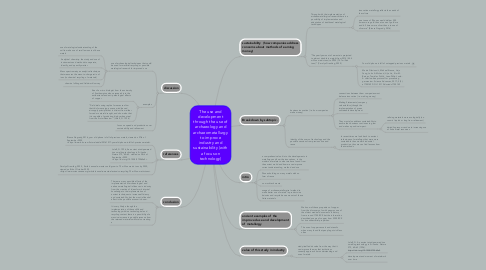
1. sustainability (how companies address concerns about methods of earning money)
1.1. Through with the implementation of archaeometallurgical research there is a possibility of implementation and adaptation of traditional metalogical techniques
1.1.1. innovation metallurgy reflects the needs of the culture
1.1.2. one tonne of iPhones would deliver 300 times more gold than a tonne of gold ore and 6.5 times more silver than a tonne of silver ore” (Bianca Nogrady, 2016)
1.2. “The yearly amount of e-waste is projected to almost double in weight from 2014 (44.4 million metric tons) to 2030 (74.7 million tons).” (Carolyn Gramling, 2020)
1.2.1. Your old phone is full of untapped precious metals
1.2.2. Martin Glavinović, Michael Krause, Linju Yang, John A. McLeod, Lijia Liu, Kim M. Baines, Tomislav Friščić, Jean-Philip Lumb. A chlorine-free protocol for processing germanium. Science Advances, 2017; 3 (5): e1700149 DOI: 10.1126/sciadv.1700149
2. discussion
2.1. use of archaeological techniques that could be used for material recycling or possible metalogical research for improved use
2.1.1. use of metalogical understanding of the soil to make use of small amounts of base metals
2.1.2. Analytical chemistry: the study and use of instruments and methods to separate, identify, and quantify matter.
2.1.3. Mass spectrometry an analytical technique that measures the mass-to-charge ratio of ions (to chemical recycling of materials)
2.1.4. chemical sifting and fieldwork/ survey
2.2. examples
2.2.1. Keevil a micro biologist from the university of Southampton whose research into the antibacterial and anti pathological effects of copper
2.2.2. "Field trials using replica furnaces confirm that this furnace type uses a wind-based air-supply principle that is distinct from either forced or natural draught, and show also that it is capable of producing high-carbon steel from the first millennium." (Juleff, G. 1996 )
2.3. focus on speed and production over sustainability and refinement
3. Breakdown by subtopic.
3.1. business innovation (i.e. how companies make money)
3.1.1. connections between them companies must balance innovation (i.e. making money)
3.1.2. Making Statements (company values/ethics),though the implementation of green sustainable development
3.1.3. They must also address sustainability to ensure their business continues to grow and makes a positive impact.
3.1.3.1. refining materials more ecologically (no cosmic liquids or slag from refinement)
3.1.3.2. dwindling resources due to increasing use of finite metal resources
3.2. identity of the users of technology and the possible sessions from previous use and reuse
3.2.1. In recent times we look back to ancient techniques of metallurgy that were more sustainable than modern industrial production. thus we can find lessons from their methods
4. intro
4.1. a comprehensive look in to the developments in metallurgy and how the innovations in the modern era relate to what we have found from the ancient world and how we can improve current understanding, method and use
4.2. Phones holding so many metals with no form of reuse
4.3. so much tech waste
4.4. usage of archaeometallurgical method to make better use of metals in products in a buissins and recycle base amounts of these finite materials
5. references
5.1. Bianca Nogrady, 2016, your old phone is full of precious metals, viewed on 27th of September 2020 <https://www.bbc.com/future/article/20161017-your-old-phone-is-full-of-precious-metals>
5.2. Juleff, G. 1996, An ancient wind-powered iron smelting technology in Sri Lanka. Nature 379, 60–63. viewed on 28th of September 2020 <https://doi.org/10.1038/379060a0>
5.3. Carolyn Gramling, 2020, Earth’s annual e-waste could grow to 75 million metric tons by 2030, viewed on 8th of October 2020 <https://www.sciencenews.org/article/annual-e-waste-electronics-recycling-75-million-metric-tons>
6. conclusion
6.1. There are many possible effects of the implementation of archaeological and archaeometallurgical influences in industry from the creation of ideas form historical knowledge to the implementation of ancient techniques to increase efficiency and sustainability, but the most influential effect is the possible economic boom.
6.2. It is very likely a though the implementation of these skills and technology within a technological and recycling context there is a possibility of a massive increase in possible revenue from the returned materials whilst also creating a
7. ancient examples of the improved use and development of metallurgy
7.1. We know of these properties of copper from the discovery of smith papyrus one of the oldest medical documents in history from around 1700 BCE but the information described usage of copper from 3200 BCE for its antibacterial properties.
7.2. The use of copper vessels and utensils when many found that people got sick less often
8. value of this study in industry
8.1. study itself adds value from the way that it can improve the way that institutions currently approach our understanding and use of metals.
8.1.1. Juleff, G. An ancient wind-powered iron smelting technology in Sri Lanka. Nature 379, 60–63 (1996). https://doi.org/10.1038/379060a0
8.1.2. development and moment of metalwork over time
